Leo constellation lies in the northern sky. It is one of the zodiac constellations and one of the largest constellations in the sky.
Leo represents the lion and is usually associated with the Nemean lion in Greek mythology. Its symbol is ♌. The constellation was first catalogued by the Greek astronomer Ptolemy in the 2nd century, along with all the other constellations of the zodiac.
Leo constellation is home to the bright stars Regulus and Denebola, the nearby star Wolf 359, and to a number of famous deep sky objects, among them galaxies Messier 65, Messier 66, Messier 95, Messier 96, Messier 105, NGC 3628, the Owl Galaxy (NGC 3758), and the Frosty Leo Nebula.
Facts, location and map
Leo is the 12th largest constellation in size, occupying an area of 947 square degrees. It is located in the second quadrant of the northern hemisphere (NQ2) and can be seen at latitudes between +90° and -65°. The neighboring constellations are Cancer, Coma Berenices, Crater, Hydra, Leo Minor, Lynx, Sextans, Ursa Major and Virgo.
The constellation name Leo is pronounced /ˈliːoʊ/. In English, the constellation is known as the Lion. The genitive form of Leo, used in star names, is Leonis (pronunciation: /liːˈoʊnɪs/). The three-letter abbreviation, adopted by the International Astronomical Union (IAU) in 1922, is Leo.
Leo contains five Messier objects: Messier 65 (M65, NGC 3623), Messier 66 (M66, NGC 3627), Messier 95 (M95, NGC 3351), Messier 96 (M96, NGC 3368), and Messier 105 (M105, NGC 3379). It has 11 stars with known planets.
Leo belongs to the Zodiac family of constellations, along with Aries, Taurus, Gemini, Cancer, Virgo, Libra, Scorpius, Sagittarius, Capricornus, Aquarius and Pisces.
The brightest star in Leo is Regulus, Alpha Leonis, with an apparent magnitude of 1.35.
Leo is one of the 15 equatorial constellations. It contains 16 named stars. The proper names of stars that have been officially approved by the International Astronomical Union (IAU) are Adhafera, Algieba, Alterf, Chertan, Denebola, Dingolay, Formosa, Moriah, Noquisi, Rasalas, Regulus, Sagarmatha, Shaomin, Subra, Yunü (Yunu), and Zosma.
There are two meteor showers associated with the constellation. The Leonids usually peak on November 17-18 every year and have a radiant near the bright star Gamma Leonis. The January Leonids are a minor shower that peaks between January 1 and 7.
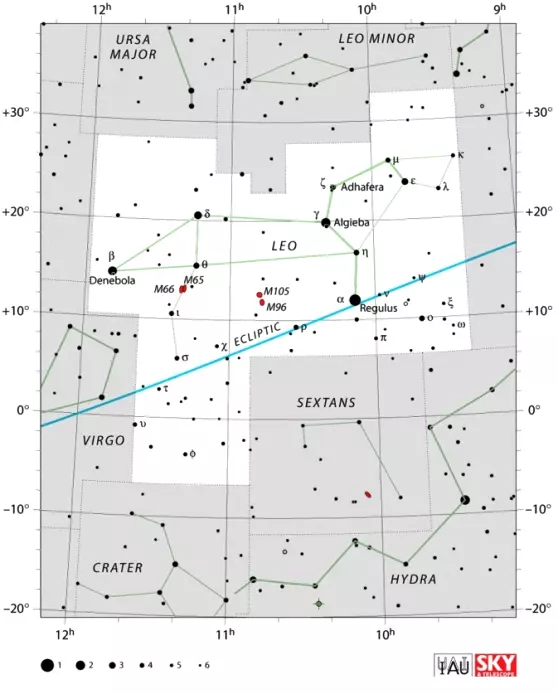
Leo constellation map by IAU and Sky&Telescope magazine
Myth
Leo is one of the oldest constellations in the sky. Archaeological evidence suggests that Mesopotamians had a constellation similar to Leo as early as 4000 BC. The Persians knew the constellation as Shir or Ser, Babylonians called it UR.GU.LA (“the great lion”), Syrians knew it as Aryo, and the Turks as Artan.
Babylonians knew the star Regulus as “the star that stands at the Lion’s breast,” or the King Star. Both the constellation and its brightest star were well-known in most ancient cultures.
The Greeks associated Leo with the Nemean lion, the beast defeated by Heracles during the first of his twelve labours. Both Eratosthenes and Hyginus wrote that the lion was placed among the constellations because it was the king of beasts.
The lion lived in a cave in Nemea, a town located to the south-west of Corinth. It set upon the local inhabitants and could not be defeated because it had impenetrable skin.
Heracles could not defeat the lion with arrows, so he trapped it in its cave, grappled with the beast and eventually defeated it. He used the lion’s claws to cut off its pelt, and then wore the pelt as a cloak, complete with the lion’s head. The cloak both protected Heracles and made him appear even more fearsome.
In the sky, the six bright stars that form the Sickle of Leo represent the lion’s head, and the brightest star in the constellation, Regulus (Alpha Leonis), marks the beast’s heart. Another bright star, Denebola (Beta Leonis) marks the tip of the lion’s tail. Algieba (Gamma Leonis) lies on the lion’s neck, even though its name means “the forehead.” Zosma (Delta Leonis) marks the lion’s rump.
Major stars in Leo
Regulus – α Leonis (Alpha Leonis)
Regulus, Alpha Leonis, is the brightest star in Leo and the 22nd brightest star in the sky. It has an apparent magnitude of 1.35 and is approximately 77 light years distant.
Regulus is a four-star system composed of two pairs of stars. Regulus A is a spectroscopic binary star composed of a blue-white main sequence star belonging to the spectral class B7 V, and a companion star which cannot be resolved, but is believed to be a white dwarf. The two stars complete an orbit around their common centre of mass every 40 days or so.
Regulus B and Regulus C share a common proper motion. They are located at an angular distance of 177 arc seconds from Regulus A. They are dimmer main sequence stars with an apparent magnitude of 8.14 and 13.5. Regulus B is a K2V star and the companion is believed to be a red dwarf of the spectral type M4V. The two stars are separated by about 100 astronomical units and have an orbital period of 2,000 years.
The primary star of Regulus A is a young star, only a few million years old, and has 3.5 times the mass of the Sun. The star is an exceptionally fast rotator, with a rotation period of only 15.9 hours. As a result, it has an oblate shape. If it were rotating 16% faster, the centripetal force provided by the star’s gravity would not be enough to hold the star together.
Alpha Leonis is the closest bright star to the ecliptic. For this reason, it is regularly occulted by the Moon and, rarely, by Mercury and Venus.
In the northern hemisphere, Regulus is best seen in the evening in the late winter and spring. The only time of year when the star can’t be seen is for a month on either side of August 22, when it lies too close to the Sun.
The star’s name, Regulus, means “little king” or “prince” in Latin. The star’s Greek name, Basiliscos, had the same meaning. The Arabic name for the star is Qalb al-Asad, which means “the heart of the lion.”
Denebola – β Leonis (Beta Leonis)
Denebola is the second brightest star in Leo and the 61st brightest star in the sky. It is a main sequence star with the stellar classification A3 V. It has an apparent magnitude of 2.113 and is approximately 35.9 light years distant from Earth. The star can easily be seen without binoculars.
Denebola has 75% more mass than the Sun, 173% of the solar radius, and is 12 times more luminous. It is classified as a Delta Scuti variable, which means that its brightness varies slightly over a period of a few hours. Denebola exhibits variations in luminosity of 0.025 magnitudes about ten times a day.
Beta Leonis is a relatively young star. Its estimated age is less than 400 million years. Like Regulus, Denebola is a rapid rotator, which results in an oblate shape of the star, with a bulge at the equator. The star’s projected rotational velocity is 128 km/s.
Denebola also exhibits a strong infrared excess, which suggests that it may have a circumstellar debris disk of dust in its orbit.
The star belongs to the IC 2391 supercluster, a stellar association whose member stars share a common motion through space, but are not gravitationally bound. Other stars that belong to this association are Alpha Pictoris in the constellation Pictor, Beta Canis Minoris in the constellation Canis Minor, and the stars in the open cluster IC 2391, also known as the Omicron Velorum Cluster, located in the constellation Vela.
The name Denebola comes from the Arabic ðanab al-asad, which means “the lion’s tail.”
Algieba – γ Leonis (Gamma Leonis)
Gamma Leonis is a double star in Leo. Its traditional name, Algieba or Al Gieba, comes from the Arabic Al-Jabhah, which means “the forehead.” The star is sometimes also known by its Latin name, Juba.
Algieba is composed of a giant star with the spectral classification K1-IIIbCN0.5 and a dimmer companion star which belongs to the spectral class G7IIICN-I. The brighter giant is 180 times more luminous than the Sun and has an apparent magnitude of 2.28. The G7 class star has a visual magnitude of 3.51, is 50 times brighter than the Sun, and has 10 times the solar diameter. The two stars have an orbital period of 500 years. A planet was discovered in the orbit of the primary star in November 2009.
The Gamma Leonis system has a combined apparent magnitude of 1.98 and is approximately 130 light years distant from the Sun. It is easy to observe in a small telescope under good conditions and appears as a bright double star with orange red and greenish yellow components.
Zosma – δ Leonis (Delta Leonis)
Zosma, Delta Leonis, is another rapid rotator in Leo, with a projected rotational velocity of 180 km/s. Like Regulus and Denebola, Zosma has an equatorial bulge and an oblate shape.
Zosma is a white main sequence star of the spectral type A4 V, approximately 58.4 light years from Earth. It has a visual magnitude of 2.56.
Delta Leonis is slightly larger and hotter than the Sun. It has 214% of the solar radius and is about 15 times more luminous than the Sun. In about 600 million years, it will become a red giant.
The star is suspected to be a member of the Ursa Major Moving Group, a group of stars that includes most of the brightest stars in Ursa Major that share a common origin and motion through space.
The star’s traditional name, Zosma, comes from ancient Greek and means “the girdle.” Zosma is located on the lion’s hip.
Chertan – θ Leonis (Theta Leonis)
Theta Leonis is another white main sequence star. It has the stellar classification A2 V and a mass 2.5 times that of the Sun. The star is visible to the unaided eye. It has an apparent magnitude of 3.324 and is approximately 165 light years distant from the solar system.
Theta Leonis has an estimated age of 550 million years, which means that it is much younger than the Sun. It exhibits an excess emission of infrared, which indicates the presence of a circumstellar disk of dust. The star has a relatively high projected rotational velocity, 23 km/s.
The star is sometimes known by its traditional names Chort (from the Arabic al-kharāt or al-khurt, which means “small rib”), Coxa (Latin for “hip”) and Chertan (from the Arabic al-kharātān, meaning “two small ribs”). The International Astronomical Union (IAU) approved the name Chertan for the star in 2016.
Al Minliar – κ Leonis (Kappa Leonis)
Kappa Leonis is a binary star with an apparent magnitude of 4.46, approximately 210 light years distant from the solar system. Its traditional name, Al Minliar, comes from the Arabic Minkhir al-Asad, which means “the muzzle of the lion.” The star has the stellar classification K2III.
Alterf – λ Leonis (Lambda Leonis)
Lambda Leonis is a K5-class star, about 336 light years from the Sun. It has an apparent magnitude of 4.32. The star’s traditional name, Alterf, comes from the Arabic aṭ-ṭarf, which means “the view (of the lion).”
Subra – ο Leonis (Omicron Leonis)
Omicron Leonis is a double star in Leo. It is approximately 135 light years distant. It is sometimes known by its traditional name, Subra.
The two components in the Omicron Leonis system belong to the spectral classes F9III (a giant) and A5mV (a main sequence star). They have a combined apparent magnitude of 3.53.
Al Jabbah – η Leonis (Eta Leonis)
Eta Leonis is white supergiant belonging to the spectral class A0 Ib. It has an apparent magnitude of 3.511 and is approximately 2,000 light years distant from Earth. While it appears relatively dim to the unaided eye, the star is 5,600 times more luminous than the Sun and has an absolute magnitude of -5.60. The star is suspected to be a part of a binary system.
Adhafera – ζ Leonis (Zeta Leonis)
Zeta Leonis is a giant star belonging to the spectral class F0 III. Its traditional name, Adhafera, comes from the Arabic al-ðafīrah, which means “the curl” or “the braid.”
Zeta Leonis has a visual magnitude of 3.33 and is about 274 light years distant from the solar system. It is 85 times more luminous than the Sun.
The star has an optical companion, 35 Leonis, which has an apparent magnitude of 5.90. 35 Leonis is located 325.9 arc seconds away from Adhafera and it is only a line-of-sight companion, as it is only 100 light years distant from Earth.
Ras Elased Borealis – μ Leonis (Mu Leonis)
Mu Leonis belongs to the spectral class K3. It has a visual magnitude of 4.1 and is about 133 light years distant from Earth. The star’s traditional names, Rasalas (or Ras Elad Borealis) and Alshemali are abbreviated from the Arabic phrase ra’s al-’asad aš-šamālī, which means “the northern (star) of the lion’s head.”
Ras Elased Australis – ε Leonis (Epsilon Leonis)
Epsilon Leonis is a bright giant of the spectral type G1 II. It has a visual magnitude of 2.98 and is the fifth brightest star in the constellation Leo. Its estimated age is 162 million years. The star is approximately 247 light years distant from Earth.
The stars’ traditional naames, Ras Elased (Australis), Asad Australis and Algenubi, are derived from the Arabic phrase rās al-’asad al-janūbī, which means “the southern star of the lion’s head.”
Epsilon Leonis is 288 times more luminous than the Sun, four times as massive, and it has 21 times the solar radius. It is classified as a Cepheid variable, changing by an amplitude of 0.3 magnitude every few days. (Cepheid variables, named after Delta Cephei in Cepheus constellation, are very luminous stars that have a direct relationship between their luminosity and pulsation period, which makes these stars important standard candles for establishing distance scales.)
Shaomin – ρ Leonis (Rho Leonis)
Rho Leonis is a binary star system located approximatly 2,900 light-years away. Its brightness varies between magnitudes 3.83 and 3.90.
The primary component in the system is a hot blue supergiant star of the spectral type B1 lab. It has 19.9 times the Sun’s mass and a radius of around 28 solar radii. With an effective temperature of 21,700 K, it shines with 151,000 solar luminosities. The star has an estimated age of only 9.12 million years.
Rho Leonis A is classified as an Alpha Cygni variable, a star whose brightness varies due to non-radial pulsations. The supergiant’s brightness varies by 0.032 magnitudes over a period of 3.427 days.
Rho Leonis is a runaway star and has a peculiar velocity of at least 30 km/s relative to the nearby stars.
In 2024, the International Astronomical Union (IAU) formally approved the name Shaomin for the primary component. Shaomin is the star’s name in traditional Chinese astronomy. Rho Leonis was one of the southernmost stars of the Xuānyuán constellation.
ι Leonis (Iota Leonis)
Iota Leonis is a spectroscopic binary star with the stellar classification F3 V. It has a visual magnitude of 4.00 and is approximately 79 light years distant from the Sun.
The components in the system are too close together to be able to resolve through a telescope.
σ Leonis (Sigma Leonis)
Sigma Leonis is a blue-white star belonging to the spectral class B9.5Vs. It has an apparent magnitude of 4.044 and is approximately 210 light years distant.
Wolf 359
Wolf 359 is a red dwarf with the stellar classification M6.5Ve. It has an apparent magnitude of 13.54 and is only 7.78 light years distant. Despite its proximity to the Sun, Wolf 359 can only be seen through a large telescope. It is one of the lowest-mass stars ever discovered, as well as one of the faintest. It emits only about 0.1% of the Sun’s energy, has 8% of the Sun’s mass, and only 16% the solar radius. The star has an estimated age of less than a billion years. It has a relatively high proper motion.
Wolf 359 is classified as a flare star, one that can undergo dramatic increases in luminosity for several minutes as a result of magnetic activity on its surface. The flares from the star emit strong bursts of gamma rays and X-ray radiation.
Wolf 359 is one of the nearest stars to the Sun. Only Alpha Centauri in the constellation Centaurus and Barnard’s Star in Ophiuchus are closer. Because of its proximity to Earth, the star is often mentioned in works of fiction. Star Trek fans will recognize it as the location of the Battle of Wolf 359, in which the Borg, led by the assimilated Captain Picard, obliterate the Starfleet ships, leaving few survivors, among them Benjamin Sisko, the future captain of Deep Space Nine. The star was also famously mentioned in an episode of The Outer Limits.
Icarus (MACS J1149 Lensed Star 1)
Icarus is the second most distant individual star discovered to date, second only to Earendel (WHL0137-LS) in the constellation Cetus. Icarus is a blue supergiant of the spectral type B, located approximately 14.4 billion light-years from Earth. Earendel is almost twice as distant, lying 28 billion light-years away.
Icarus was discovered in 2018 by a team of astronomers who were studying the multiply lensed supernova SN Refsdal with the Hubble Space Telescope. Both Icarus and the supernova were visible in the field of the massive galaxy cluster MACS J1149+2223, which acted as a gravitational lens for both objects. The light of the star took 9.34 billion years to reach Earth. The co-moving distance of 14.4 billion ly does not correspond to the lookback time because it takes into account the expansion of the universe in the time that it took for the star’s light to reach us.
Gliese 436
Gliese 436 is another red dwarf located relatively close to the Sun. It has a visual magnitude of 10.67 and is 33.1 light years distant. It belongs to the spectral class M2.5 V.
An extrasolar planet, Gliese 436b, was discovered in the star’s orbit in 2004, and the presence of another planet, UCF-1.01, was confirmed in 2012.
CW Leonis (IRC + 10216)
CW Leonis is a carbon star embedded in a thick envelope of dust. It is between 390 and 490 light years distant from the Sun. The star was first discovered in 1969 by the American astrophysicist Eric Brecklin and his team of astronomers.
CW Leonis is at a late stage of its evolution, blowing off its outer layer to eventually become a white dwarf. The gaseous envelope, rich in carbon, is some 69,000 years old and the star is losing an enormous amount of mass each year. Its extended envelope is believed to have at least 1.4 solar masses of ejected material.
The star exhibits variations in brightness over a period of 649 days. It has a nominal luminosity of 11,300 times that of the Sun, but this varies over the course of the pulsation cycle, from 6,250 to 15,800 times the Sun’s luminosity. Consequently, its apparent magnitude varies too, ranging from 1.19 to 10.96.
R Leonis
R Leonis is a red giant star of the spectral type M8IIIe. It has a visual magnitude varying from 4.4 to 11.3 with a period of 312 days and is classified as a Mira variable. Mira variables are pulsating variable stars that are in the late stage of evolution, very red in colour, and with pulsation periods longer than 100 days. They eventually expel their outer envelopes to form planetary nebulae and become white dwarfs within a few million years.
R Leonis is approximately 370 light years distant from the solar system. When it is at its brightest, it can be seen without binoculars, and when it is on the dimmest end of the spectrum, one needs at least a 7 cm telescope to see the star. R Leonis has a radius 320-350 times solar.
Yunü – 31 Leonis
31 Leonis is a binary system located approximately 296 light-years away. With an apparent magnitude of 4.39, it is visible to the unaided eye.
The primary component, 31 Leonis A, is an evolved red giant star of the spectral type K3.5 IIIb Fe-1. It has a radius 33.9 times that of the Sun and is 283 times more luminous than the Sun.
The companion, 31 Leonis B, is much fainter. It has an apparent magnitude of 13.6 and is separated by 7.9 arcseconds from the primary star.
In 2024, the International Astronomical Union approved the name Yunü (Yunu) for 31 Leonis A. It is the star’s traditional name in Chinese astronomy.
Deep sky objects in Leo
Messier 65 (M65, NGC 3623)
Messier 65 is an intermediate spiral galaxy in Leo. It has an apparent magnitude of 10.25 and is approximately 35 million light years distant. The galaxy was discovered by Charles Messier in 1780. Messier 65, Messier 66 and NGC 3628 form the famous Leo Triplet galaxy group.
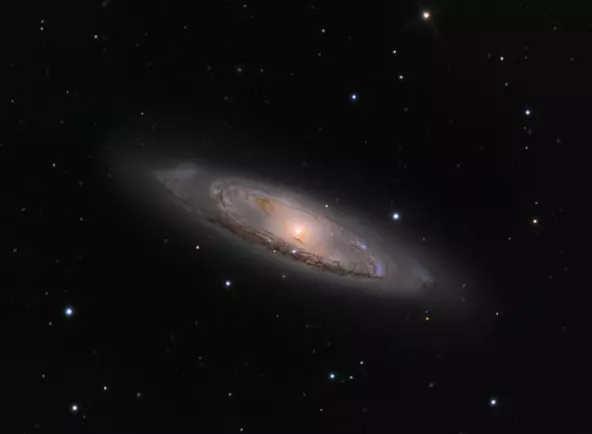
Messier 65, image: Adam Block/Mount Lemmon SkyCenter/University of Arizona (CC BY-SA 4.0)
M65 does not contain much dust and gas and there isn’t much star formation occurring in it. Most of the stars in the galaxy are old. The galaxy’s disk appears slightly warped, which, along with some recent starburst activity, suggests that the galaxy is interacting with another object.
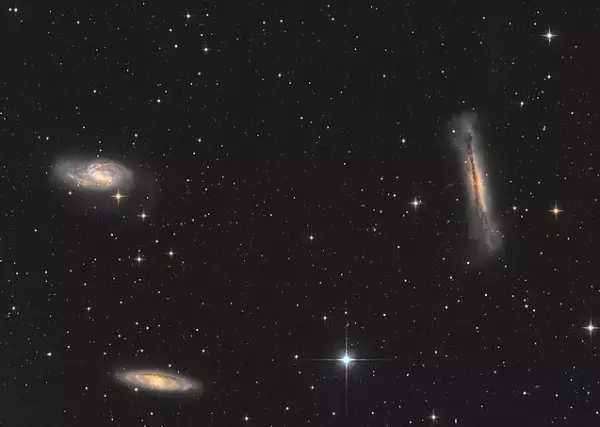
Leo Triplet, image: Wikimedia Commons/Marekmazuch (CC BY-SA 4.0)
Messier 66 (M66, NGC 3627)
Messier 66 is an intermediate spiral galaxy in Leo. Charles Messier discovered it in 1780. The galaxy has a visual magnitude of 8.9 and is about 36 million light years distant.
M66 is approximately 95,000 light years across and notable for its dust lanes and bright star clusters. It is part of the Leo Triplet, along with M65 and NGC 3628.
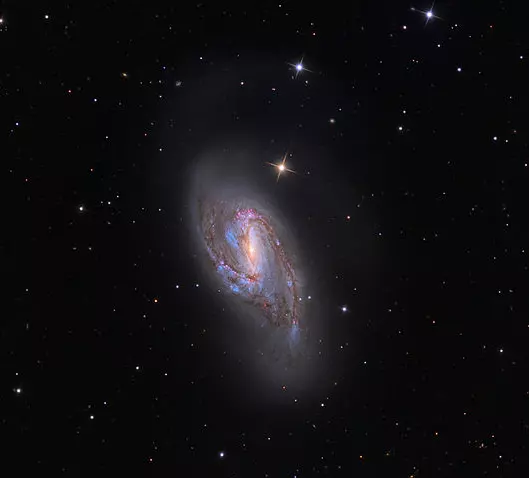
Messier 66, image: Adam Block/Mount Lemmon SkyCenter/University of Arizona (CC BY-SA 4.0)
M66 and NGC 3628 had an encounter in the past, and the gravitational interaction between the two resulted in an exceptionally high central mass concentration in M66, a high molecular to atomic mass ratio, and a resolved noncorotating clump of H I material being removed from one of M66’s spiral arms.
NGC 3628
NGC 3628 is an unbarred spiral galaxy approximately 35 million light years distant from the solar system. It was discovered by William Herschel in 1784.
The galaxy is notable for having a long tidal tail spanning about 300,000 light years, and a broad, obscuring dust band along the outer edge of its spiral arms. Along with Messier 65 and Messier 66, NGC 3628 forms the Leo Triplet galaxy group.
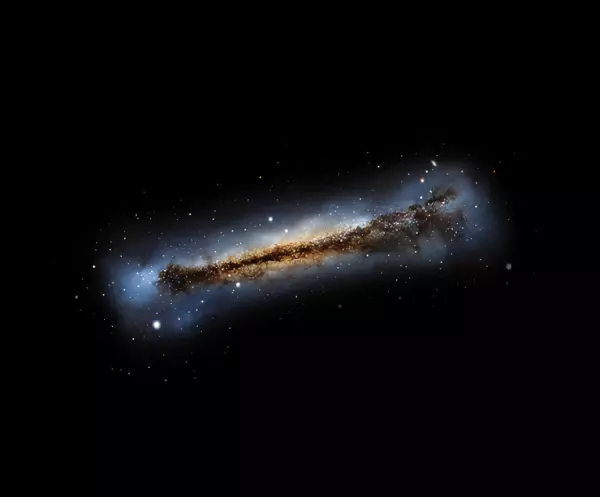
NGC 3628, image: Pablo Carlos Budassi (CC BY-SA 4.0)
Messier 95 (M95, NGC 3351)
Messier 95 is a barred spiral galaxy in Leo. It has a visual magnitude of 11.4 and is approximately 38 million light years distant. The central region of M95 has a ring-shaped starburst region around the core with a diameter spanning about 2,000 light years.
The galaxy was discovered by the French astronomer Pierre Méchain in 1781 and Charles Messier subsequently included it in his catalogue four days later.
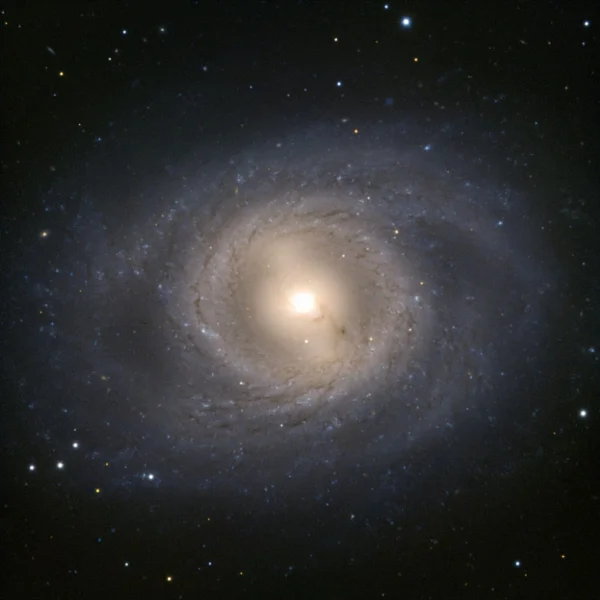
The galaxy Messier 95 stands boldly face-on, offering an ideal view of its spiral structure. The spiral arms form an almost perfect circle around the galactic centre before they spread out, creating a mane-like effect of which any lion would be proud. Another, perhaps even more striking, feature of Messier 95 is its blazing golden core. It contains a nuclear star-forming ring, almost 2000 light-years across, where a large proportion of the galaxy’s star formation takes place. This phenomenon occurs mostly in barred spiral galaxies such as Messier 95 and our home, the Milky Way. In the Leo I group, Messier 95 is outshone by its brother Messier 96. Messier 96 is in fact the brightest member of the group and — as “leader of the pride” — also gives Leo I its alternative name of the M 96 group. Nevertheless, Messier 95 also makes for a spectacular image. Photo: ESO
M95 belongs to the M96 Group of galaxies, which also includes M96 and M105, and also at least nine other galaxies.
A supernova was observed in M95 in March 2012.
Messier 96 (M96, NGC 3368)
Messier 96 is another intermediate spiral galaxy in Leo constellation. It has an apparent magnitude of 10.1 and is about 31 million light years distant.
M96 is the brightest galaxy in the M96 Group. It was discovered by Pierre Méchain on March 20, 1781 and then included in Messier’s catalogue a few days later.
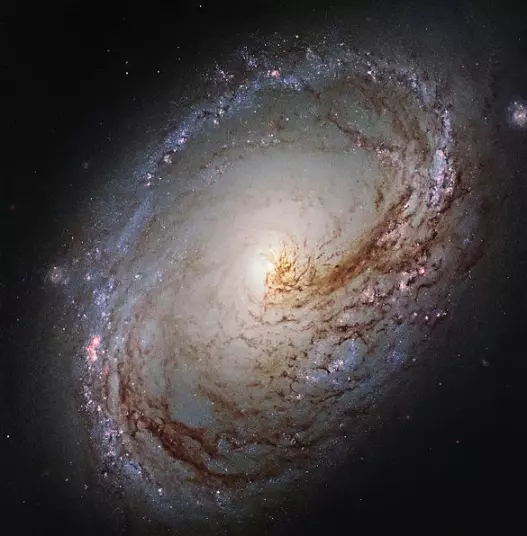
This new NASA/ESA Hubble Space Telescope shows Messier 96, a spiral galaxy just over 35 million light-years away in the constellation of Leo (The Lion). It is of about the same mass and size as the Milky Way. It was first discovered by astronomer Pierre Méchain in 1781, and added to Charles Messier’s famous catalogue of astronomical objects just four days later. The galaxy resembles a giant maelstrom of glowing gas, rippled with dark dust that swirls inwards towards the nucleus. Messier 96 is a very asymmetric galaxy; its dust and gas is unevenly spread throughout its weak spiral arms, and its core is not exactly at the galactic centre. Its arms are also asymmetrical, thought to have been influenced by the gravitational pull of other galaxies within the same group as Messier 96. This group, named the M96 Group, also includes the bright galaxies Messier 105 and Messier 95, as well as a number of smaller and fainter galaxies. It is the nearest group containing both bright spirals and a bright elliptical galaxy (Messier 105). Image: ESA/Hubble & NASA and the LEGUS Team, acknowledgement: R. Gendler
The galaxy is classified as a double-barred spiral with a small inner bulge through the centre along with an outer bulge. Ultraviolet emissions from the galaxy’s central region suggest that it has a supermassive black hole at its core.
A Type Ia supernova, SN 1998bu, was discovered in M96 in May 1998.
Messier 105 (M105, NGC 3379)
Messier 105 is an elliptical galaxy in Leo. It has a visual magnitude of 10.2 and is approximately 32 million light years distant. The galaxy is known to have a supermassive black hole at its centre.
M105 was discovered by Pierre Méchain in March 1781, a few days after he had first observed M95 and M96.
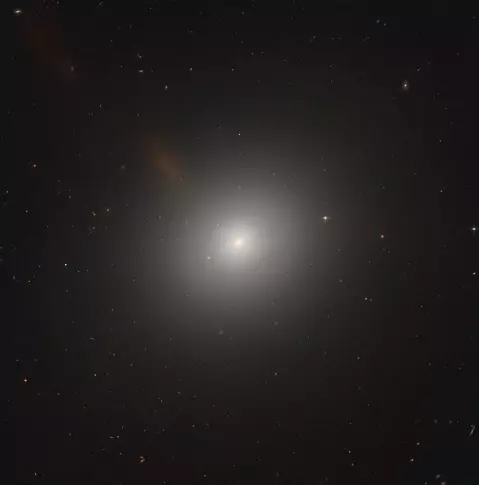
It might appear featureless and unexciting at first glance, but NASA/ESA Hubble Space Telescope observations of this elliptical galaxy — known as Messier 105 — show that the stars near the galaxy’s centre are moving very rapidly. Astronomers have concluded that these stars are zooming around a supermassive black hole with an estimated mass of 200 million Suns! This black hole releases huge amounts of energy as it consumes matter falling into it and causing the centre to shine far brighter than its surroundings. This system is known as an active galactic nucleus. Image: Hubble ESA (CC BY 2.0)
Leo Ring
The Leo Ring is an enormous primordial cloud of hydrogen and helium found in orbit of two galaxies in the Leo constellation. The cloud was discovered by radio astronomers in 1983.
NGC 3607
NGC 3607 is a spiral galaxy in Leo. It has a visual magnitude of 10.8 and is a member of the Leo II Group (NGC 3607 Group) of galaxies.
NGC 3593
NGC 3593 is a spiral galaxy in Leo. It has an apparent magnitude of 12.6.
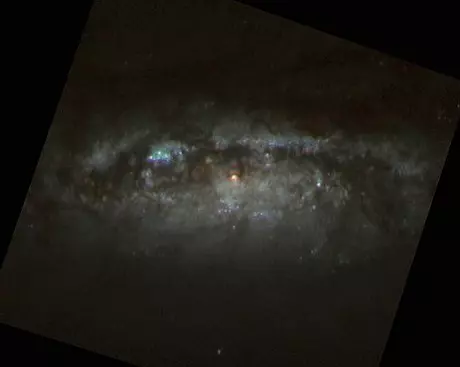
NGC 3593, image: NASA/ESA – The Hubble Legacy Archive (HLA): Space Telescope Science Institute (STScI), the Space Telescope European Coordinating Facility (ST-ECF), and the Canadian Astronomy Data Centre (CADC) – zoranknez (Aladin software)
NGC 3384
NGC 3384 is an elliptical galaxy, approximately 35.1 million light years distant. It was discovered by William Herschel in 1784. The stars in the galaxy’s central region are very old. More than 80% of them are Population II stars, more than a billion years old.
NGC 3384 belongs to the M96 Group (Leo I Group) of galaxies.
NGC 3842
NGC 3842 is an elliptical galaxy, notable for having one of the largest black holes known. The black hole at the centre of the galaxy is believed to have a mass of 9.7 billion solar masses.
The galaxy has an apparent magnitude of 12.8 and is approximately 331 million light years distant from Earth.
NGC 3596
NGC 3596 is an intermediate spiral galaxy with a visual magnitude of 12.0. It was discovered by William Herschel in 1784. The galaxy can be found below the bright star Theta Leonis.
NGC 2903
NGC 2903 is a barred spiral galaxy. It has a visual magnitude of 9.7 and is approximately 30.6 million light years distant from the Sun. The galaxy was discovered by William Herschel in 1784.
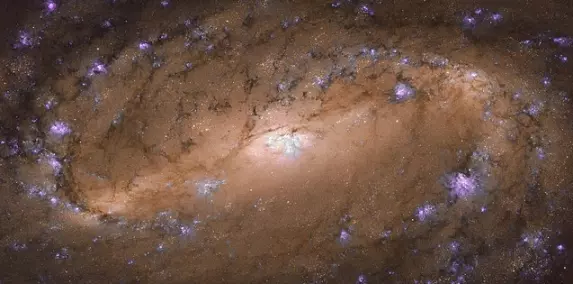
Few of the Universe’s residents are as iconic as the spiral galaxy. These limelight-hogging celestial objects combine whirling, pinwheeling arms with scatterings of sparkling stars, glowing bursts of gas, and dark, weaving lanes of cosmic dust, creating truly awesome scenes — especially when viewed through a telescope such as the NASA/ESA Hubble Space Telescope. In fact, this image from Hubble frames a perfect spiral specimen: the stunning NGC 2903. Image: ESA/Hubble & NASA, L. Ho et al. (CC BY 4.0)
NGC 3626
NGC 3626 is a medium-tightness spiral galaxy in Leo. It has a visual magnitude of 10.6/10.9. The galaxy lies in the vicinity of the bright star Delta Leonis (Zosma). It is approximately 70 million light years distant.
The galaxy belongs to the NGC 3607 Group, one of the many Leo II groups of galaxies.
NGC 3357
NGC 3357 is an elliptical galaxy in Leo. It was discovered by the German astronomer Albert Marth on April 5, 1864.